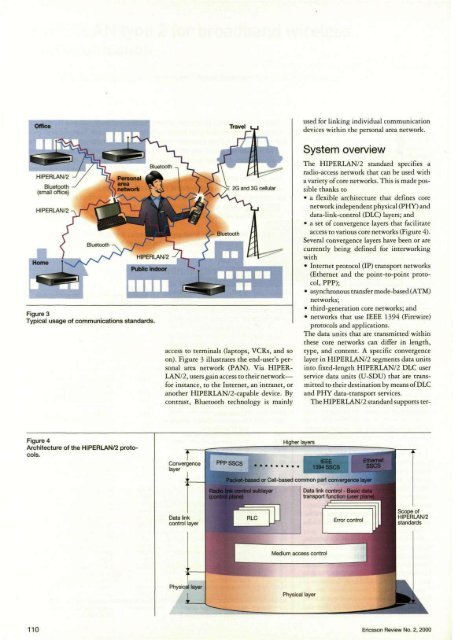ericssonhistory.com
ericssonhistory.com
ericssonhistory.com
- No tags were found...
Create successful ePaper yourself
Turn your PDF publications into a flip-book with our unique Google optimized e-Paper software.
Figure 3Typical usage of <strong>com</strong>munications standards.access to terminals (laptops, VCRs, and soon). Figure 3 illustrates the end-user's personalarea network (PAN). Via HIPER-LAN/2, users gain access to their network—for instance, to the Internet, an intranet, oranother HIPERLAN/2-capable device. Bycontrast, Bluetooth technology is mainlyused for linking individual <strong>com</strong>municationdevices within the personal area network.System overviewThe HIPERLAN/2 standard specifies aradio-access network that can be used witha variety of core networks. This is made possiblethanks to• a flexible architecture that defines corenetwork independent physical (PHY) anddata-link-control (DLC) layers; and• a set of convergence layers that facilitateaccess to various core networks (Figure 4).Several convergence layers have been or arecurrently being defined for interworkingwith• Internet protocol (IP) transport networks(Ethernet and the point-to-point protocol,PPP);• asynchronous transfer mode-based (ATM)networks;• third-generation core networks; and• networks that use IEEE 1394 (Firewire)protocols and applications.The data units that are transmitted withinthese core networks can differ in length,type, and content. A specific convergencelayer in HIPERLAN/2 segments data unitsinto fixed-length HIPERLAN/2 DLC userservice data units (U-SDU) that are transmittedto their destination by means of DLCand PHY data-transport services.The HIPERLAN/2 standard supports ter-Figure 4Architecture of the HIPERLAN/2 protocols.110 Ericsson Review No. 2, 2000















